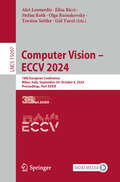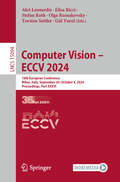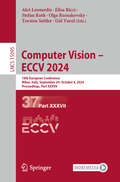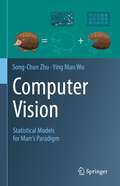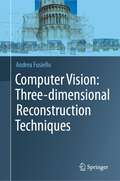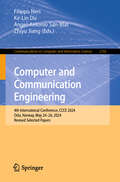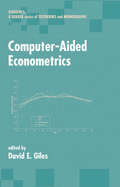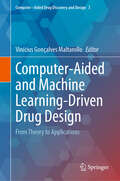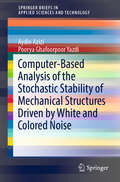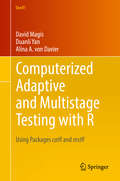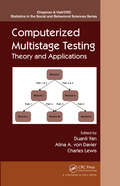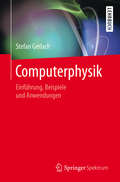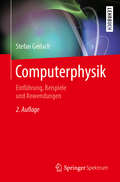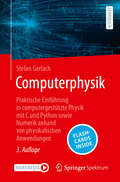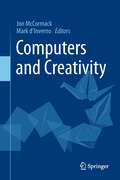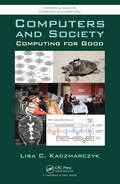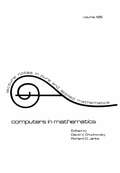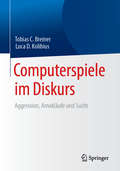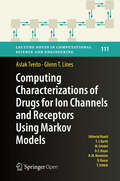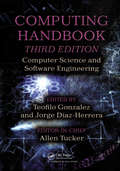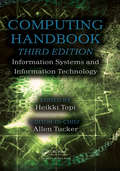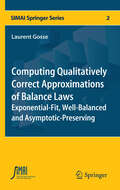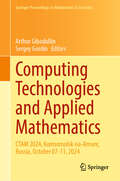- Table View
- List View
Computer Vision – ECCV 2024: 18th European Conference, Milan, Italy, September 29–October 4, 2024, Proceedings, Part XXXIX (Lecture Notes in Computer Science #15097)
by Stefan Roth Aleš Leonardis Elisa Ricci Torsten Sattler Olga Russakovsky Gül VarolThe multi-volume set of LNCS books with volume numbers 15059 up to 15147 constitutes the refereed proceedings of the 18th European Conference on Computer Vision, ECCV 2024, held in Milan, Italy, during September 29–October 4, 2024. The 2387 papers presented in these proceedings were carefully reviewed and selected from a total of 8585 submissions. The papers deal with topics such as computer vision; machine learning; deep neural networks; reinforcement learning; object recognition; image classification; image processing; object detection; semantic segmentation; human pose estimation; 3d reconstruction; stereo vision; computational photography; neural networks; image coding; image reconstruction; motion estimation.
Computer Vision – ECCV 2024: 18th European Conference, Milan, Italy, September 29–October 4, 2024, Proceedings, Part XXXVI (Lecture Notes in Computer Science #15094)
by Stefan Roth Aleš Leonardis Elisa Ricci Torsten Sattler Olga Russakovsky Gül VarolThe multi-volume set of LNCS books with volume numbers 15059 up to 15147 constitutes the refereed proceedings of the 18th European Conference on Computer Vision, ECCV 2024, held in Milan, Italy, during September 29–October 4, 2024. The 2387 papers presented in these proceedings were carefully reviewed and selected from a total of 8585 submissions. They deal with topics such as computer vision; machine learning; deep neural networks; reinforcement learning; object recognition; image classification; image processing; object detection; semantic segmentation; human pose estimation; 3d reconstruction; stereo vision; computational photography; neural networks; image coding; image reconstruction; object recognition; motion estimation.
Computer Vision – ECCV 2024: 18th European Conference, Milan, Italy, September 29–October 4, 2024, Proceedings, Part XXXVII (Lecture Notes in Computer Science #15095)
by Stefan Roth Aleš Leonardis Elisa Ricci Torsten Sattler Olga Russakovsky Gül VarolThe multi-volume set of LNCS books with volume numbers 15059 up to 15147 constitutes the refereed proceedings of the 18th European Conference on Computer Vision, ECCV 2024, held in Milan, Italy, during September 29–October 4, 2024. The 2387 papers presented in these proceedings were carefully reviewed and selected from a total of 8585 submissions. The papers deal with topics such as computer vision; machine learning; deep neural networks; reinforcement learning; object recognition; image classification; image processing; object detection; semantic segmentation; human pose estimation; 3d reconstruction; stereo vision; computational photography; neural networks; image coding; image reconstruction; motion estimation.
Computer Vision – ECCV 2024: 18th European Conference, Milan, Italy, September 29–October 4, 2024, Proceedings, Part XXXVIII (Lecture Notes in Computer Science #15096)
by Stefan Roth Aleš Leonardis Elisa Ricci Torsten Sattler Olga Russakovsky Gül VarolThe multi-volume set of LNCS books with volume numbers 15059 up to 15147 constitutes the refereed proceedings of the 18th European Conference on Computer Vision, ECCV 2024, held in Milan, Italy, during September 29–October 4, 2024. The 2387 papers presented in these proceedings were carefully reviewed and selected from a total of 8585 submissions. The papers deal with topics such as computer vision; machine learning; deep neural networks; reinforcement learning; object recognition; image classification; image processing; object detection; semantic segmentation; human pose estimation; 3d reconstruction; stereo vision; computational photography; neural networks; image coding; image reconstruction; motion estimation.
Computer Vision: Statistical Models for Marr's Paradigm
by Song-Chun Zhu Ying Nian WuAs the first book of a three-part series, this book is offered as a tribute to pioneers in vision, such as Béla Julesz, David Marr, King-Sun Fu, Ulf Grenander, and David Mumford. The authors hope to provide foundation and, perhaps more importantly, further inspiration for continued research in vision. This book covers David Marr's paradigm and various underlying statistical models for vision. The mathematical framework herein integrates three regimes of models (low-, mid-, and high-entropy regimes) and provides foundation for research in visual coding, recognition, and cognition. Concepts are first explained for understanding and then supported by findings in psychology and neuroscience, after which they are established by statistical models and associated learning and inference algorithms. A reader will gain a unified, cross-disciplinary view of research in vision and will accrue knowledge spanning from psychology to neuroscience to statistics.
Computer Vision: Three-dimensional Reconstruction Techniques
by Andrea FusielloFrom facial recognition to self-driving cars, the applications of computer vision are vast and ever-expanding. Geometry plays a fundamental role in this discipline, providing the necessary mathematical framework to understand the underlying principles of how we perceive and interpret visual information in the world around us. This text explores the theories and computational techniques used to determine the geometric properties of solid objects through images. It covers the basic concepts and provides the necessary mathematical background for more advanced studies. The book is divided into clear and concise chapters covering a wide range of topics including image formation, camera models, feature detection and 3D reconstruction. Each chapter includes detailed explanations of the theory as well as practical examples to help the reader understand and apply the concepts presented. The book has been written with the intention of being used as a primary resource for students on university courses in computer vision, particularly final year undergraduate or postgraduate computer science or engineering courses. It is also useful for self-study and for those who, outside the academic field, find themselves applying computer vision to solve practical problems. The aim of the book is to strike a balance between the complexity of the theory and its practical applicability in terms of implementation. Rather than providing a comprehensive overview of the current state of the art, it offers a selection of specific methods with enough detail to enable the reader to implement them.
Computer and Communication Engineering: 4th International Conference, CCCE 2024, Oslo, Norway, May 24–26, 2024, Revised Selected Papers (Communications in Computer and Information Science #2192)
by Ke-Lin Du Filippo Neri Zhiyu Jiang Angel-Antonio San-BlasThis book constitutes the proceedings of the 4th International Conference on Computer and Communication Engineering, CCCE 2024, which took place in Oslo, Norway, during May 24-26, 2024. The 19 full papers included in this book were carefully reviewed and selected from 47 submissions. They are organized in topical sections as follows: Intelligent image analysis and multimedia technology; information network and security; digital communication and information systems; and design and implementation of modern information management systems.
Computer-Aided Econometrics
by David E. A. GilesEmphasizing the impact of computer software and computational technology on econometric theory and development, this text presents recent advances in the application of computerized tools to econometric techniques and practices—focusing on current innovations in Monte Carlo simulation, computer-aided testing, model selection, and Bayesian methodology for improved econometric analyses.
Computer-Aided and Machine Learning-Driven Drug Design: From Theory to Applications (Computer-Aided Drug Discovery and Design #3)
by Vinícius Gonçalves MaltarolloThe computer-aided drug design research field comprises several different knowledge areas, and often, researchers are only familiar or experienced with a small fraction of them. Indeed, pharmaceutical industries and large academic groups rely on a broad range of professionals, including chemists, biologists, pharmacists, and computer scientists. In this sense, it is difficult to be an expert in every single CADD approach. Furthermore, there are well-established methods that are constantly revisited, and novel approaches are introduced, such as machine-learning based scoring functions for molecular docking. This book provides an organized update of the most commonly employed CADD techniques, as well as successful examples of actual applications to develop bioactive compounds/drug candidates. Also includes is a section of case studies that cover certain pharmacological/target classes, focusing on the applications of the previously described methods. This part will especially appeal to professionals who are not as interested in the theoretical aspects of CADD. This is an ideal book for students, researchers, and industry professionals in the fields of pharmacy, chemistry, biology, bioinformatics, computer sciences, and medicine who are seeking a go-to reference on drug design and medicinal chemistry.
Computer-Based Analysis of the Stochastic Stability of Mechanical Structures Driven by White and Colored Noise (SpringerBriefs in Applied Sciences and Technology)
by Aydin Azizi Poorya Ghafoorpoor YazdiThis book provides a concise introduction to the behavior of mechanical structures and testing their stochastic stability under the influence of noise. It explains the physical effects of noise and in particular the concept of Gaussian white noise. In closing, the book explains how to model the effects of noise on mechanical structures, and how to nullify / compensate for it by designing effective controllers.
Computerized Adaptive and Multistage Testing with R: Using Packages catR and mstR (Use R!)
by Duanli Yan David Magis Alina A. von DavierThe goal of this guide and manual is to provide a practical and brief overview of the theory on computerized adaptive testing (CAT) and multistage testing (MST) and to illustrate the methodologies and applications using R open source language and several data examples. Implementation relies on the R packages catR and mstR that have been already or are being developed by the first author (with the team) and that include some of the newest research algorithms on the topic. The book covers many topics along with the R-code: the basics of R, theoretical overview of CAT and MST, CAT designs, CAT assembly methodologies, CAT simulations, catR package, CAT applications, MST designs, IRT-based MST methodologies, tree-based MST methodologies, mstR package, and MST applications. CAT has been used in many large-scale assessments over recent decades, and MST has become very popular in recent years. R open source language also has become one of the most useful tools for applications in almost all fields, including business and education. Though very useful and popular, R is a difficult language to learn, with a steep learning curve. Given the obvious need for but with the complex implementation of CAT and MST, it is very difficult for users to simulate or implement CAT and MST. Until this manual, there has been no book for users to design and use CAT and MST easily and without expense; i. e. , by using the free R software. All examples and illustrations are generated using predefined scripts in R language, available for free download from the book's website.
Computerized Multistage Testing: Theory and Applications (Chapman & Hall/CRC Statistics in the Social and Behavioral Sciences)
by Charles Lewis Duanli Yan Alina A. von DavierUnlike other forms of adaptive testing, multistage testing (MST) is highly suitable for testing educational achievement because it can be adapted to educational surveys and student testing. This volume provides the first unified source of information on the design, psychometrics, implementation, and operational use of MST. It shows how to apply theoretical statistical tools to testing in novel and useful ways. It also explains how to explicitly tie the assumptions made by each model to observable (or at least inferable) data conditions.
Computerphysik: Einführung, Beispiele und Anwendungen
by Stefan GerlachDieses Lehrbuch bietet dem Leser eine aktuelle Einführung in das Lösen von physikalischen Problemen mit dem Computer. Es werden die Grundlagen der Computernutzung, der Programmierung sowie der wichtigsten numerischen Methoden besprochen und anhand vieler Beispiele und Übungsaufgaben mit zunehmendem Bezug zur Physik verdeutlicht. Die Nutzung des Betriebssystems Linux und die Programmierung in C und Python bilden dabei den Schwerpunkt. Der wichtigste Teil des Buches sind die Projekte, in denen die zuvor besprochenen Grundlagen auf unterschiedliche Probleme der Physik angewendet werden. Die Projekte umfassen viele wichtige Beispiele aus der Computerphysik (u. a. den Oszillator und Anfangswertprobleme) und diskutieren deren Anwendungen im Detail. Der Leser erhält damit das nötige Rüstzeug, um selbstständig physikalische Probleme mit Hilfe des Computers zu lösen. Zahlreiche Übungsaufgaben helfen dabei.
Computerphysik: Einführung, Beispiele und Anwendungen
by Stefan GerlachDieses Lehrbuch bietet dem Leser eine aktuelle Einführung in das Lösen von physikalischen Problemen mit dem Computer. Die Grundlagen der Computernutzung, der Programmierung sowie der wichtigsten numerischen Methoden werden besprochen und anhand vieler Beispiele und Übungsaufgaben mit zunehmendem Bezug zur Physik verdeutlicht. Die Nutzung des Betriebssystems Linux und die Programmierung in C und Python bilden dabei die Schwerpunkte.Der wichtigste Teil des Buches umfasst die Projekte, in denen die zuvor besprochenen Grundlagen auf unterschiedliche Probleme der Physik angewendet werden. Die Projekte beinhalten viele wichtige Beispiele aus der Computerphysik (u.a. den Oszillator und Anfangswertprobleme) und diskutieren deren Anwendungen im Detail. Der Leser erhält damit das nötige Rüstzeug, um selbstständig physikalische Probleme mithilfe des Computers zu lösen. Zahlreiche Übungsaufgaben unterstützen beim Vertiefen des Erlernten.Neben einer Vielzahl an kleinen Ergänzungen und Verbesserungen ist die zweite Auflage um ein zusätzliches Projektkapitel zum Thema Daten- und Signalanalyse erweitert, wobei wichtige Themen wie statistische Methoden, Filtermethoden und Bildanalyse behandelt werden.Dieses Buch ist in erster Linie für Bachelorstudenten der Physik, aber auch anderer naturwissenschaftlicher Fächer gedacht. Es kann aber auch von Lehrern und Dozenten zur eigenen Vorbereitung genutzt werden. Vorkenntnisse auf dem Gebiet setzt dieses Buch nicht voraus. Nur in den Projekten wird auf Wissen aus den Grundvorlesungen der Physik zurückgegriffen.
Computerphysik: Praktische Einführung in computergestützte Physik mit C und Python sowie Numerik anhand von physikalischen Anwendungen
by Stefan GerlachPhysikalische Aufgaben mit dem Computer zu lösen, ist eine zunehmend wichtige Kompetenz. Dieses Lehrbuch führt Sie durch alle erforderlichen Schritte, beginnend bei den Grundlagen von Computern über die Programmierung und Datenverarbeitung hin zu den numerischen Methoden bis zu konkreten physikbezogenen Projekten. Besonderheiten: Mit diesem Buch wird das Grundwissen für wissenschaftliches Arbeiten gelegt, denn Begrifflichkeiten wie Datenkompetenz und Forschungsdatenmanagement inklusive Open Science und Gute wissenschaftliche Praxis sind längst nicht mehr aus der Wissenschaft wegzudenken. Kapitelweise wird das Erlernte mit vielen Beispielen, Übungen mit Lösungen, digitalen Karteikarten sowie Online-Programmcodes verdeutlicht und auf bekannte Probleme der Physik angewandt. Der Inhalt: 1. Einleitung – 2. Hard- und Software – 3. Datenspeicherung – 4. Arbeiten mit Linux – 5. Programmieren in C – 6. Programmieren in Python – 7. Wissenschaftliches Rechnen – 8. Arbeiten mit Daten – 9. Hochleistungsrechner – 10. Zahlendarstellung und Numerische Fehler – 11. Numerische Standardverfahren – 12. Numerik von gewöhnlichen Differenzialgleichungen – 13. Verfahren der linearen Algebra – 14. Zufallszahlen – 15. Der Oszillator – 16. Nichtlineare Dynamik – 17. Randwertprobleme – 18. Anfangswertprobleme – 19. Eigenwertprobleme – 20. Daten- und Signalanalyse – 21. Stochastische Methoden Neuerungen: In der 3. Auflage wurden alle Kapitel aktualisiert, teilweise erweitert und zwei neue zu Datenspeicherung und Datenverarbeitung ergänzt. Kapitelweise wurden Flashcards und Jupyter Notebooks neu eingeführt. Die Zielgruppe: Dieses Buch ist in erster Linie gedacht für Bachelorstudierende der Physik, aber auch anderer naturwissenschaftlicher Fächer sowie deren Lehrende. Vorkenntnisse: Computerwissen, Linux, C, Python u. Git werden nicht vorausgesetzt. Nur in Projekten wird auf Wissen aus den Grundvorlesungen der Physik zurückgegriffen.
Computers and Creativity
by Jon Mccormack Mark D’invernoThis interdisciplinary volume introduces new theories and ideas on creativity from the perspectives of science and art. Featuring contributions from leading researchers, theorists and artists working in artificial intelligence, generative art, creative computing, music composition, and cybernetics, the book examines the relationship between computation and creativity from both analytic and practical perspectives. Each contributor describes innovative new ways creativity can be understood through, and inspired by, computers. The book tackles critical philosophical questions and discusses the major issues raised by computational creativity, including: whether a computer can exhibit creativity independently of its creator; what kinds of creativity are possible in light of our knowledge from computational simulation, artificial intelligence, evolutionary theory and information theory; and whether we can begin to automate the evaluation of aesthetics and creativity in silico. These important, often controversial questions are contextualised by current thinking in computational creative arts practice. Leading artistic practitioners discuss their approaches to working creatively with computational systems in a diverse array of media, including music, sound art, visual art, and interactivity. The volume also includes a comprehensive review of computational aesthetic evaluation and judgement research, alongside discussion and insights from pioneering artists working with computation as a creative medium over the last fifty years. A distinguishing feature of this volume is that it explains and grounds new theoretical ideas on creativity through practical applications and creative practice. Computers and Creativity will appeal to theorists, researchers in artificial intelligence, generative and evolutionary computing, practicing artists and musicians, students and any reader generally interested in understanding how computers can impact upon creativity. It bridges concepts from computer science, psychology, neuroscience, visual art, music and philosophy in an accessible way, illustrating how computers are fundamentally changing what we can imagine and create, and how we might shape the creativity of the future. Computers and Creativity will appeal to theorists, researchers in artificial intelligence, generative and evolutionary computing, practicing artists and musicians, students and any reader generally interested in understanding how computers can impact upon creativity. It bridges concepts from computer science, psychology, neuroscience, visual art, music and philosophy in an accessible way, illustrating how computers are fundamentally changing what we can imagine and create, and how we might shape the creativity of the future.
Computers and Society: Computing for Good (Chapman And Hall/crc Textbooks In Computing Ser.)
by Lisa C. KaczmarczykSince computer scientists make decisions every day that have societal context and influence, an understanding of society and computing together should be integrated into computer science education. Showing students what they can do with their computing degree, Computers and Society: Computing for Good uses concrete examples and case studies to high
Computers in Mathematics (Lecture Notes In Pure And Applied Mathematics Ser. #Vol. 113)
by V. ChudnovskyTalks from the International Conference on Computers and Mathematics held July 29-Aug. 1, 1986, Stanford U. Some are focused on the past and future roles of computers as a research tool in such areas as number theory, analysis, special functions, combinatorics, algebraic geometry, topology, physics,
Computers: Understanding Technology (Brief 4th Edition)
by Floyd Fuller Brian LarsonThe book introduces students to the key information technology concepts and the vital technical skills that can help improve their personal and professional lives. Studying this book will help prepare students for the workplace of today--and tomorrow--in which some level of computer skills is often an essential requirement for employment.
Computerspiele im Diskurs: Aggression, Amokläufe und Sucht
by Tobias C. Breiner Luca D. KolibiusDieses Fachbuch ist eine umfassende Abhandlung zur Debatte um die negativen Auswirkungen von Computerspielen: Aggressionen, Amokläufe und Sucht. Die kontroverse Debatte zur Beziehung zwischen Computerspielen und Aggression wird hier auf Grundlage neuster wissenschaftlicher Erkenntnisse aufgearbeitet. Darüber hinaus inspirierte die Aufnahme in die aktuellste Version des Klassifikationssystems DSM für Internet Gaming Disorder (Computerspielsucht) eine Vielzahl wissenschaftlicher Veröffentlichungen, welche hier übersichtlich zusammengetragen werden. In diesem Buch finden Sie die Antworten auf folgende Fragen: Welche Symptome machen eine Computerspielabhängigkeit aus und welche Therapiemöglichkeiten gibt es?Geht Computerspielsucht mit Veränderungen im Gehirn und der Persönlichkeit einher?Gibt es eine kausale Beziehung zwischen Computerspielen einerseits und Aggressivität und Amokläufen andererseits? Die Autoren kommen dabei nach Sichtung der Studienlage zu überraschenden Erkenntnissen. Dieses Buch unterstützt Psychologen, Psychotherapeuten, Psychiater, Pädagogen, Therapeuten, Lehrkräfte und Eltern die Welt der Computerspiele zu navigieren.
Computing Characterizations of Drugs for Ion Channels and Receptors Using Markov Models (Lecture Notes in Computational Science and Engineering #111)
by Aslak Tveito Glenn T. LinesFlow of ions through voltage gatedchannels can be represented theoretically using stochastic differentialequations where the gating mechanism is represented by a Markov model. The flow through achannel can be manipulated using various drugs, and the effect of a given drugcan be reflected bychanging the Markov model. These lecture notes provide an accessibleintroduction to the mathematical methods needed to deal with these models. They emphasize the use ofnumerical methods and provide sufficient details for the reader to implementthe models and thereby study the effect of various drugs. Examples in thetext include stochastic calcium release from internal storage systems in cells,as well as stochasticmodels of the transmembrane potential. Well known Markov models are studied anda systematic approach toincluding the effect of mutations is presented. Lastly, the book shows how to derive the optimal propertiesof a theoretical model of a drug for a given mutation defined in termsof a Markov model.
Computing Handbook: Computer Science and Software Engineering
by Teofilo Gonzalez Jorge Diaz-HerreraThe first volume of this popular handbook mirrors the modern taxonomy of computer science and software engineering as described by the Association for Computing Machinery (ACM) and the IEEE Computer Society (IEEE-CS). Written by established leading experts and influential young researchers, it examines the elements involved in designing and implementing software, new areas in which computers are being used, and ways to solve computing problems. The book also explores our current understanding of software engineering and its effect on the practice of software development and the education of software professionals.
Computing Handbook: Information Systems and Information Technology
by Heikki Topi Allen TuckerThe second volume of this popular handbook demonstrates the richness and breadth of the IS and IT disciplines. The book explores their close links to the practice of using, managing, and developing IT-based solutions to advance the goals of modern organizational environments. Established leading experts and influential young researchers present introductions to the current status and future directions of research and give in-depth perspectives on the contributions of academic research to the practice of IS and IT development, use, and management.
Computing Qualitatively Correct Approximations of Balance Laws: Exponential-Fit, Well-Balanced and Asymptotic-Preserving (SEMA SIMAI Springer Series #2)
by Laurent GosseSubstantial effort has been drawn for years onto the development of (possibly high-order) numerical techniques for the scalar homogeneous conservation law, an equation which is strongly dissipative in L1 thanks to shock wave formation. Such a dissipation property is generally lost when considering hyperbolic systems of conservation laws, or simply inhomogeneous scalar balance laws involving accretive or space-dependent source terms, because of complex wave interactions. An overall weaker dissipation can reveal intrinsic numerical weaknesses through specific nonlinear mechanisms: Hugoniot curves being deformed by local averaging steps in Godunov-type schemes, low-order errors propagating along expanding characteristics after having hit a discontinuity, exponential amplification of truncation errors in the presence of accretive source terms... This book aims at presenting rigorous derivations of different, sometimes called well-balanced, numerical schemes which succeed in reconciling high accuracy with a stronger robustness even in the aforementioned accretive contexts. It is divided into two parts: one dealing with hyperbolic systems of balance laws, such as arising from quasi-one dimensional nozzle flow computations, multiphase WKB approximation of linear Schrödinger equations, or gravitational Navier-Stokes systems. Stability results for viscosity solutions of onedimensional balance laws are sketched. The other being entirely devoted to the treatment of weakly nonlinear kinetic equations in the discrete ordinate approximation, such as the ones of radiative transfer, chemotaxis dynamics, semiconductor conduction, spray dynamics or linearized Boltzmann models. "Caseology" is one of the main techniques used in these derivations. Lagrangian techniques for filtration equations are evoked too. Two-dimensional methods are studied in the context of non-degenerate semiconductor models.
Computing Technologies and Applied Mathematics: CTAM 2024, Komsomolsk-na-Amure, Russia, October 07-11, 2024 (Springer Proceedings in Mathematics & Statistics #500)
by Arthur Gibadullin Sergey GordinThis proceedings volume convenes revised, selected works presented at the 3rd International Seminar on Computing Technologies and Applied Mathematics (CTAM2024), held at Komsomolsk-na-Amure State University, Russia, from October 7 to 11, 2024. The seminar brought together a diverse group of international experts and young scientists from Germany, China, South Korea, Uzbekistan, and Russia to exchange the latest results and original ideas on the use of computing technologies and applied mathematics tools in both fundamental and applied research. Topics covered in this volume include the development of theoretical foundations, methods, and algorithms for implementing mathematical and computational models. The subjects ranged from health to logistics, with many devoted to algorithm optimization. Industrial applications are also covered, with studies of digital twins and quantum and evolutionary algorithms. By bridging academia and industry, this volume can benefit graduate students, experienced researchers, and industry practitioners alike, fostering both practical implementations in real-world scenarios and innovative avenues of applied research.
